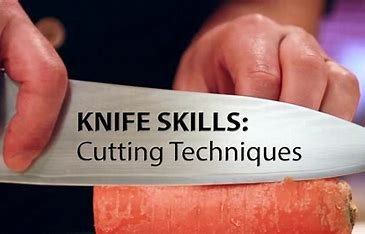Knife skills are often underestimated, but they are absolutely essential for several reasons, especially when you’re just starting out in the kitchen.

1. Safety
- Proper Technique = Less Risk: When you use a knife incorrectly or without control, accidents like cuts and slips are more likely to happen. Learning how to hold a knife properly and cut with a firm grip reduces the risk of injury.
- Sharp Knives Are Safer: While it may seem counterintuitive, a sharp knife is actually safer than a dull one. A dull blade requires more force, which increases the likelihood of slipping and cutting yourself. Keeping your knives sharp ensures smoother, more controlled cuts.
2. Efficiency
- Faster Prep: With the right knife skills, you can chop, slice, and dice much more quickly. This is especially helpful when you’re preparing meals and want to reduce prep time. Good knife technique allows you to move through ingredients smoothly and with precision.
- Consistent Results: Evenly cut vegetables, meat, or fruit not only look better but also cook more evenly. For example, if you’re chopping onions for a stir-fry, all pieces will cook at the same rate, preventing some from being overcooked while others are undercooked.
3. Better Presentation
- Aesthetics Matter: How food is cut can affect the visual appeal of a dish. Whether you’re slicing tomatoes for a salad, julienning carrots for a stir-fry, or chopping herbs for garnish, uniform cuts make food look more appealing and professional.
- Texture and Taste: The way you cut ingredients can impact the texture and cooking time, which in turn affects the final taste. For example, thinly sliced garlic will release more flavor quickly than thicker chunks. Consistency in slicing can help your dishes come out as intended.
4. Improved Control
- Precision: Good knife skills give you more control over the food you’re preparing. This is especially important when dealing with slippery or delicate ingredients like tomatoes or fish fillets, where precision matters to avoid squishing or tearing.
- Adaptability: Once you’ve mastered basic knife skills, you can handle a variety of cutting tasks—whether it’s filleting fish, chiffonading basil, or dicing an onion—without needing multiple tools or excessive effort.
5. More Enjoyable Cooking Experience
- Confidence: Knowing how to use your knives effectively can boost your confidence in the kitchen. You’ll feel more in control and be able to handle complex recipes with ease.
- Less Frustration: Poor knife skills can lead to frustration—food that’s unevenly cut, difficult to handle, or taking much longer to prepare than necessary. By practicing good technique, you can make cooking more enjoyable and less stressful.
6. Better Flavor Extraction
- Maximizing Flavor: Cutting food in certain ways can help extract more flavor. For example, finely minced garlic releases more oils and flavor than large chunks. In the same way, chopping herbs finely allows them to be more evenly distributed in your dish, enhancing overall flavor.
- Even Cooking: Consistent cuts allow food to cook more evenly, ensuring the flavors meld together in a harmonious way.
How to Improve Knife Skills:
- Practice the Basics: Start by mastering basic cuts—like chopping, dicing, and slicing—before moving to more advanced techniques like chiffonade or julienne.
- Use the Right Knife for the Job: Different knives are designed for different tasks. For example, use a chef’s knife for chopping and a paring knife for peeling.
- Keep Knives Sharp: A sharp knife will make cutting much easier and safer. Regularly hone and sharpen your knives.
- Focus on Proper Grip and Technique: Hold the knife handle firmly, with your index finger and thumb gripping the base of the blade, while your other fingers wrap around the handle. Use the “claw” technique with your non-cutting hand to protect your fingers.
- Work Slowly at First: Take your time to build up your skill. As you get more comfortable with the motions, you’ll naturally get faster and more precise.
